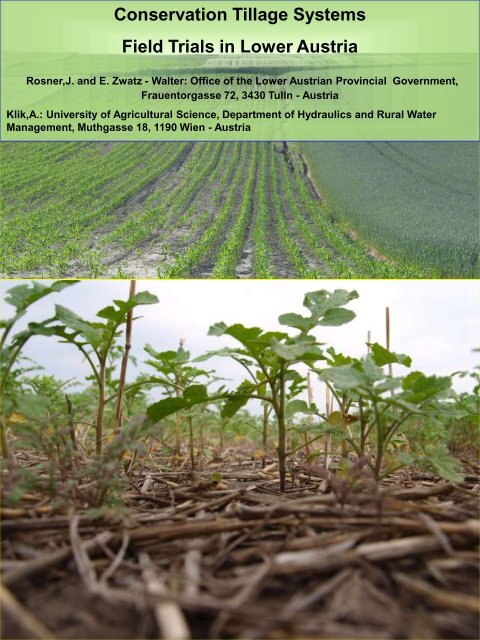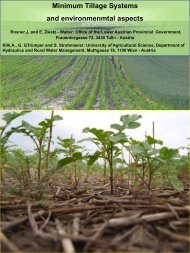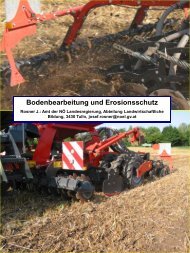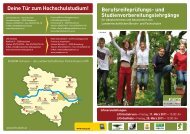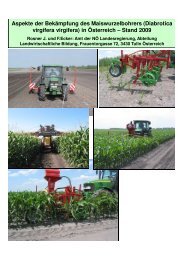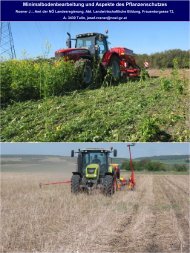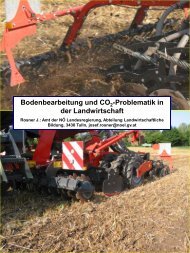Conservation Tillage Systems Field Trials in Lower Austria
and direct - Land-Impulse
and direct - Land-Impulse
You also want an ePaper? Increase the reach of your titles
YUMPU automatically turns print PDFs into web optimized ePapers that Google loves.
<strong>Conservation</strong> <strong>Tillage</strong> <strong>Systems</strong><br />
<strong>Field</strong> <strong>Trials</strong> <strong>in</strong> <strong>Lower</strong> <strong>Austria</strong><br />
Rosner,J. and E. Zwatz - Walter: Office of the <strong>Lower</strong> <strong>Austria</strong>n Prov<strong>in</strong>cial Government,<br />
Frauentorgasse 72, 3430 Tulln - <strong>Austria</strong><br />
Klik,A.: University of Agricultural Science, Department of Hydraulics and Rural Water<br />
Management, Muthgasse 18, 1190 Wien - <strong>Austria</strong>
damage of settlement after a stormevent
Slaked ditches<br />
Mai 2008 Tulln<br />
<strong>Lower</strong> <strong>Austria</strong><br />
Conventional tillage with <strong>in</strong>terrill<br />
and rill erosion
Interrillerosion<br />
Mulch and direct seed
Cultivation across the slope – no erosion control
Tullnerfeld – Gollarn 2009
Direct drill<strong>in</strong>g – erosion control
Direct drill<strong>in</strong>g<br />
Conventional<br />
seed
Göllersdorf 2nd July 2010
Direct drill<strong>in</strong>g without<br />
disc harrow <strong>in</strong> front of<br />
seeder
No till drill <strong>in</strong>to straw of w<strong>in</strong>ter wheat<br />
Yellow mustard + California bluebell – Phacelia as cover crops
Legumes
Anaerobe straewmat
International tendencies <strong>in</strong><br />
<strong>Tillage</strong><br />
•1989.............. 10 Mio ha No Till<br />
•2001............ 65 Mio. ha No Till<br />
•2002............ 68 Mio. ha No Till<br />
•2004............ 72 Mio. ha No Till<br />
•2006………. 90 Mio. ha No Till<br />
•2010……….>115 Mio. ha No Till<br />
•Countries:<br />
USA (25 Mio. ha), Canada (12 Mio. ha), Brasil,<br />
Argent<strong>in</strong>a – Lat<strong>in</strong> America > 50 Mio. ha,<br />
Australia (> 10 Mio. ha)<br />
More than 98 % of the No Till land <strong>in</strong> these<br />
countries
Reasons for No Till<br />
•<strong>Lower</strong><strong>in</strong>g of production cost<br />
•Fewer passes – less work time less soil<br />
compaction<br />
•Increased productivity – cultivation of larger<br />
area possible<br />
•Reduction of fuel consumption<br />
( 250 l 80 l/ha )<br />
•<strong>Lower</strong> mach<strong>in</strong>e use<br />
•Prevention of w<strong>in</strong>d – water – tillage erosion<br />
•Increased humus content<br />
•Improved water retention<br />
•Better yield<br />
•<strong>Lower</strong> carbon dioxide release from the soil<br />
climate – and soil alliance - Kyoto<br />
Agreement
Kuhn Speedl<strong>in</strong>er<br />
Pneumatiic Drill seed<br />
Mulch – und Direct<br />
seed<strong>in</strong>g
<strong>Field</strong> demonstration <strong>Lower</strong> <strong>Austria</strong> August 2009<br />
500 participants
Vaederstad Carrier Drill
Kerner<br />
Vaederstad Rapid
Vaederstad Spirit
Vaederstad Spirit<br />
Vaederstad Seed Hawk
Vaederstad Seed Hawk
Vaederstad Seed Hawk
Corn planter for<br />
No Till<br />
Canada
K<strong>in</strong>ze 250 corn<br />
planter for no till<br />
Coulter discs<br />
Rotary clod<br />
breaker
No Till sunflower<br />
Tulln 2005
Amazone corn<br />
planter for<br />
mulch and<br />
NoTill
Direct drill<strong>in</strong>g<br />
corn under wet<br />
soil conditions
Matermac<br />
Curved t<strong>in</strong>es
Kuhn Planter 2
Monosem
Gaspardo Reg<strong>in</strong>a
Direct drill<strong>in</strong>g<br />
w<strong>in</strong>terwheat <strong>in</strong>to<br />
stubbles of<br />
sunflower
Cultivation Test 2007<br />
Seed<strong>in</strong>g W<strong>in</strong>ter Wheat<br />
<strong>in</strong>to stubbles of<br />
Sunflower
Direct drill<strong>in</strong>g w<strong>in</strong>ter wheat <strong>in</strong>to stubbles of<br />
corn <strong>Lower</strong> <strong>Austria</strong> 2009
Pioneer crop: : 2009 corn – disc harrow W<strong>in</strong>tergerste - Mulchseed with Kuhn Speedl<strong>in</strong>er<br />
September 2009<br />
Cover crop seed<strong>in</strong>d July 29th 2010
Risk dry rot<br />
Fusarium sp.<br />
NoTill corn Tulln
occurrence<br />
F. Gram<strong>in</strong>earum 30%<br />
F. Avenaceum 14%<br />
F. Poa 12%<br />
F. Tric<strong>in</strong>ctum 2%<br />
F. Sporotrichoides
Blank<strong>in</strong>g gaps<br />
<strong>in</strong> corn after<br />
w<strong>in</strong>terrye<br />
covercrop<br />
Wilt plants<br />
Wireworm and<br />
frit fly attracted<br />
by the high<br />
content of<br />
organic matter <strong>in</strong><br />
the mulch seed<br />
plots
No <strong>Tillage</strong> sugar beets<br />
<strong>Lower</strong> <strong>Austria</strong><br />
Yield:<br />
2005…….80 t/ha<br />
2008….> 70 t/ha<br />
Sugar content 2005…17.6 %
Strip – farm<strong>in</strong>g<br />
Dill – California Bluebell (Phacelia<br />
tanacetifolia) after Rye – pollen<br />
harvest<br />
NoTill sugarbeets<br />
seeded <strong>in</strong>to mustard
frost<br />
Management of cover<br />
crops<br />
shred<br />
???<br />
Silage and anaerobic zone <strong>in</strong> the<br />
plowsole Avoided by roots
Angle iron 6 cm high and 18 cm distant<br />
Roller to squeeze cover crops <strong>in</strong> fall –<br />
reduction of water consumption
Cover crop roller developed and constructed <strong>in</strong> <strong>Lower</strong><br />
<strong>Austria</strong> (Hahnekamp, Rosner)<br />
<strong>in</strong>stead of shredd<strong>in</strong>g lower fuel consumption and more capacity
yield hayage direct drill test<br />
<strong>Lower</strong> <strong>Austria</strong> 2009<br />
direct seed drill<br />
with disc harrow<br />
geen matter hayage Nov. 4th 2009<br />
green matter hayage t/ha Oct. 20th 2009<br />
direct seed drill<br />
without tools<br />
0 10 20 30 40 50 60 70 t/ha
Soil erosion measurement sites <strong>Austria</strong><br />
Pyhra<br />
N = 883mm, T = 8,6°C<br />
Pixendorf<br />
N = 768mm, T = 9,5°C<br />
N = 686mm, T = 8,1°
Experiments started <strong>in</strong> 1994<br />
soil texture:<br />
sandy silt - loamy silt<br />
plot size: 60 m² ( 4 by 15 m)<br />
slope: 5 - 16 %<br />
crop rotation: corn - w<strong>in</strong>ter wheat<br />
corn - w<strong>in</strong>ter wheat - sugar -beets<br />
– summer barley -<br />
sunflower - w<strong>in</strong>ter wheat<br />
Summer harvest - cover crop spr<strong>in</strong>g<br />
cultivation<br />
Parameters <strong>in</strong>vestigated: runoff, soil loss,<br />
nutrients, pesticides - herbicides,
6 m<br />
Erosion plots
Measurement site Mistelbach
Sediment flow – grassed waterway
Sample divider<br />
Sedimentcollector<br />
3 % sampled – divided by tubes
Losses <strong>in</strong> differnet tillage practise<br />
1994 - 2009<br />
Klik et.al<br />
University of Agricultural Science Vienna<br />
Conventional<br />
<strong>Tillage</strong> mulchseed Direct drill<strong>in</strong>g<br />
Soil loss t/ha 6.1 1.8 1.0<br />
reduction 70% 83%<br />
Corg - loss kg/ha 76.7 27.5 17.8<br />
reduction 64% 75%<br />
N - loss kg/ha 9,2 3.7 2.5<br />
reduction 61% 73%<br />
P - loss kg/ha 4.7 1.3 0.75<br />
reduction 72% 84%<br />
runoff <strong>in</strong> mm 21,4 20.94 19.37<br />
Herbicide loss<br />
% sprayed 2.20% 1.01% 0.57%<br />
reduction 55% 74%<br />
Herbicide loss<br />
im runoff 1,73% 0,87% 0,17%<br />
reduction 50% 90%<br />
Herbicide loss<br />
In sediment 3.09% 1.16% 1.99%<br />
reduction 62% 36%
Yield <strong>in</strong> relative % 1994 – 2009 Mistelbach-<br />
Pyhra(St.Pölten)-Pixendorf(Tulln)<br />
Rosner, Zwatz, Wurst, Spieß<br />
<strong>Tillage</strong> method/ Yield kg<br />
per ha<br />
Mistelbach Pyhra Pixendorf<br />
Conventional<br />
Cultivator – plow<br />
No cover crop<br />
100 100 100<br />
Cultivator – Mulchseed –<br />
Cover Crop: yellow<br />
mustard, california<br />
bluebell, buckwheat, red<br />
clover, oil radish<br />
Cultivator – direct<br />
drill<strong>in</strong>g<br />
Cover crop : 7 kg/ha<br />
California Bluebell, 3 kg/ha<br />
Yellow Mustard<br />
96 103 102<br />
90 110 104<br />
Cultivator – direct<br />
drill<strong>in</strong>g<br />
cover crop : 80 kg/ha<br />
w<strong>in</strong>ter rye<br />
89<br />
101<br />
95<br />
Cultivator – direct<br />
drill<strong>in</strong>g<br />
Cover crop :120 kg/ha<br />
summer barley<br />
97<br />
110<br />
112
mm<br />
24,00<br />
runoff <strong>in</strong> mm<br />
23,00<br />
22,00<br />
conventional<br />
21,00<br />
20,00<br />
19,00<br />
mulchseed<br />
18,00<br />
17,00<br />
direct drill<strong>in</strong>g<br />
16,00<br />
15,00<br />
90<br />
C organic loss kg/ha<br />
80<br />
70<br />
60<br />
50<br />
40<br />
30<br />
20<br />
10<br />
0<br />
Conventional Mulchseed Direct Drill<strong>in</strong>g
Cultivation Test Tulln and Pixendorf<br />
1999 - 2009<br />
<strong>Tillage</strong> method Yield %<br />
conventional<br />
Conventional <strong>Tillage</strong><br />
Cultivator-Plow-<br />
Seedbedpreparation<br />
Reduced - Chisel Plow<br />
2 x<br />
Reduced <strong>Tillage</strong> (Disc<br />
Harrow 1x)<br />
Tulln<br />
Pixendorf<br />
100 100<br />
99 100<br />
93 94<br />
No Till NT 90 91
Results <strong>Tillage</strong> trials<br />
all locations <strong>Lower</strong> <strong>Austria</strong> 1999 - 2009<br />
<strong>Tillage</strong> method Yield %<br />
conventional<br />
Net profit<br />
Conventional <strong>Tillage</strong><br />
Cultivator-Plow-<br />
Seedbedpreparation<br />
Reduced - Chisel Plow<br />
2 x<br />
Reduced <strong>Tillage</strong> (Disc<br />
Harrow 1x)<br />
100 100<br />
99 111<br />
93 108<br />
No Till NT 88 104
Mycotox<strong>in</strong> marg<strong>in</strong>al values<br />
Feedstuffs<br />
Common Union 2006<br />
Pigs<br />
DON 500 µg/kg<br />
Breed<strong>in</strong>g Sow<br />
DON 500 µg/kg<br />
ZON 50 µg/kg<br />
Chicken<br />
DON 1500 µg/kg<br />
Feed<strong>in</strong>g Cattle<br />
DON 1000 µg/kg<br />
Food:<br />
Cereals……………………….DON 1250 µg/kg<br />
Durum, corn, oat……………DON 1750 µg/kg<br />
Children`s food……………..DON 200 µg/kg<br />
Cereals……………………… ZON 100 µg/kg
DON values <strong>Lower</strong> <strong>Austria</strong><br />
Semi aride climate<br />
DON чg/kg Pixendorf Pixendorf<br />
2009 mehrjährig<br />
corn % DON<br />
<strong>Tillage</strong> system NÖ<br />
Conventional <strong>Tillage</strong> 1590 100<br />
M<strong>in</strong>imum <strong>Tillage</strong> < 150 108<br />
(cultivator/disc horrow 2x)<br />
M<strong>in</strong>imum <strong>Tillage</strong>
DON чg/kg Hollabrunn Tulln<br />
<strong>Tillage</strong> system NÖ<br />
2009 corn<br />
2008<br />
w<strong>in</strong>terwheat<br />
Conventional <strong>Tillage</strong> 298 252<br />
M<strong>in</strong>imum <strong>Tillage</strong> < 150 106<br />
(cultivator/disc horrow 2x)<br />
M<strong>in</strong>imum <strong>Tillage</strong> < NWG 126<br />
(cultivator/disc harrow 1x)<br />
No <strong>Tillage</strong> < NWG 219
DON чg/kg<br />
Tulln<br />
Several years<br />
<strong>Tillage</strong> system NÖ<br />
Conventional <strong>Tillage</strong> 1019<br />
M<strong>in</strong>imum <strong>Tillage</strong> 2028<br />
(cultivator/disc horrow 2x)<br />
M<strong>in</strong>imum <strong>Tillage</strong> 934<br />
(cultivator/disc harrow 1x)<br />
No <strong>Tillage</strong> 661
Fungicide Test Tulln 2006<br />
Triticum Durum<br />
No <strong>Tillage</strong><br />
Disc Harrow 1x<br />
Sw <strong>in</strong>g Gold + Caramba<br />
82<br />
230 Pronto Plus<br />
Without Fungicide<br />
460<br />
Sw <strong>in</strong>g Gold + Caramba<br />
110<br />
Pronto Plus 600<br />
Without Fungicide<br />
820<br />
Chisel Plow 2x<br />
Conventional<br />
<strong>Tillage</strong><br />
Sw <strong>in</strong>g Gold + Caramba<br />
90<br />
Pronto Plus<br />
630<br />
Without Fungicide<br />
Sw <strong>in</strong>g Gold + Caramba<br />
100<br />
680<br />
Pronto Plus<br />
490<br />
Without Fungicide<br />
810<br />
0 200 400 600 800 1000<br />
DON ppm
Figure 1: number and weight of Earthworms 0-30 cm<br />
2004 - 2006<br />
No <strong>Tillage</strong><br />
M<strong>in</strong>imum <strong>Tillage</strong> Disc Harrow<br />
Conventional <strong>Tillage</strong> Chisel Plow -<br />
Plow<br />
0 5 10 15 20 25 30 35 40<br />
Eartworms g/m²<br />
Earthworms/m²
Tests of CO 2 emission by cultivation<br />
CT<br />
RT<br />
NT<br />
Fuel consumption(l/ha) 57,38 28,37 6,19<br />
Work<strong>in</strong>g time(m<strong>in</strong>/ha) 125,51 56,94 14,58<br />
CO 2 Emissionfactor 3,15:<br />
70,00<br />
60,00<br />
180,76 kg CO 2 /ha 89,36 kg CO 2 /ha 19,50 kg CO 2 /ha<br />
seed<strong>in</strong>g(rotary cultivator+seed drill 3 m)<br />
CT und RT; NT:Väderstad 3 m)<br />
50,00<br />
40,00<br />
19,46<br />
Plow 4 plowshare, 1,52<br />
m)<br />
Disc harrow (3 m)<br />
30,00<br />
20,00<br />
32,19<br />
23,78<br />
10,00<br />
0,00<br />
5,74<br />
4,59<br />
6,19<br />
CT RT NT
l/ha<br />
40<br />
fuel consumption l/ha Obersiebenbrunn sandy soil August 2009<br />
35<br />
30<br />
9,9<br />
mulch seed drill<br />
deep cultivator<br />
cultivator-w<strong>in</strong>g shares<br />
6,8<br />
cultivator doublespread- w<strong>in</strong>gshares<br />
rotary cultivator+seeddrill<br />
25<br />
plow<br />
disc harrow<br />
20<br />
17,5<br />
16,7<br />
15<br />
10<br />
5<br />
7,6<br />
7,4<br />
8,7<br />
7,7<br />
0<br />
plow cultivator cultivator +<br />
deep<br />
cultivator<br />
mulch<br />
direct<br />
drill<strong>in</strong>g
CO 2 emission kg/ha Obersiebenbrunn August 2009<br />
100<br />
90<br />
mulch seed drill<br />
deep cultivator<br />
80<br />
26,3<br />
cultivator-w<strong>in</strong>g shares<br />
cultivator doublespread- w<strong>in</strong>gshares<br />
17,9<br />
rotary cultivator+seeddrill<br />
70<br />
plow<br />
disc harrow<br />
60<br />
50<br />
46,4<br />
44,3<br />
40<br />
30<br />
21,4<br />
20<br />
10<br />
20,2<br />
19,7<br />
22,9<br />
20,3<br />
0<br />
plow cultivator cultivator +<br />
deep<br />
cultivator<br />
mulch<br />
direct<br />
drill<strong>in</strong>g
fuel consumption and CO2 emission<br />
Hollabrunn 2010<br />
100<br />
94<br />
l/ha<br />
CO2 emission/ha<br />
90<br />
90<br />
80<br />
70<br />
60<br />
50<br />
40<br />
41,4<br />
39,3<br />
36<br />
30<br />
20<br />
15,7<br />
14 14<br />
10<br />
6,1 6,1<br />
0<br />
disc<br />
harrow +<br />
plow +<br />
rotary<br />
cultivation<br />
seed drill<br />
cultivator +<br />
deeper<br />
loos<strong>in</strong>g +<br />
mulchseed<br />
cultivator +<br />
rotary<br />
cultivation<br />
seed drill<br />
mulchseed<br />
with discs<br />
mulchseed<br />
without<br />
discs
Conclusion<br />
•Mulch –and direct –seed<strong>in</strong>g systems are fully developed and<br />
go well <strong>in</strong> practice.<br />
•The economical benefits must not ignore the nutrient –<br />
pesticide and soil movement (erosion).<br />
•Cereal – maize crop rotation need a shallow mulch of crop<br />
residuals for a fast decomposition as a phytosanitary need.<br />
•After harvest the growth of volunteer cereals has to be<br />
<strong>in</strong>terrupted, they stand for a green bridge for plant diseases<br />
like barley yellow dwarf virus or Fusarium sp. and pests like<br />
aphids as a vector for the virus (“green bridge)<br />
•An immediately seed<strong>in</strong>g of cover crops after harvest for a<br />
good development of the green manure.<br />
•The production of Mycotox<strong>in</strong>s by Fusarium disease (Dry<br />
Rot) is to be <strong>in</strong>terrupted by shallow soil tillage and an<br />
adopted crop rotation, fungicides are sometimes necessary.<br />
•A reduction of the costs is possible and usefull.<br />
•A prescription is not possible and depends from the crop<br />
rotation and natural situation.


